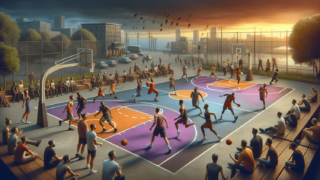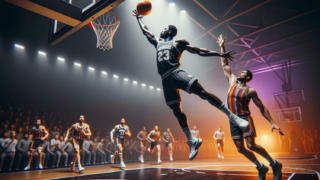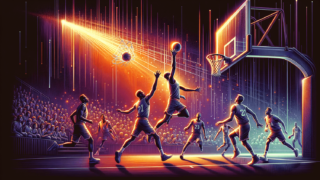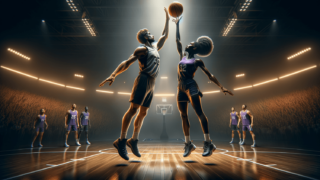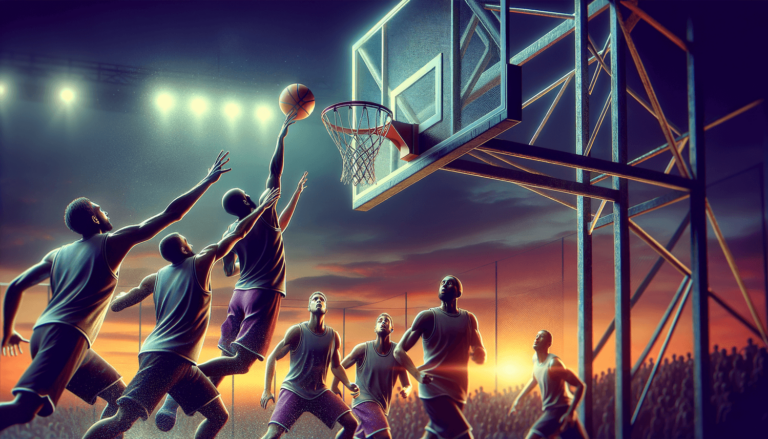
What Is the Purpose of the Backboard in Basketball?
Written by: Basketball Universe
Last updated:

Picture this: you’re standing on a basketball court, ready to shoot the perfect hoop, and you can’t help but notice the formidable structure that stands behind the hoop – the backboard. In this blog post, we’ll dive deep into the realm of basketball fundamentals, exploring the vital role that the backboard plays in the game we all know and love. By the end of this post, you’ll be a backboard aficionado, armed with the knowledge to impress your fellow basketball enthusiasts. So, join us as we unravel the fascinating history, science, and art behind this seemingly inconspicuous but essential component of the sport.
What Is the Purpose of the Backboard in Basketball?
The purpose of the backboard in basketball is to provide a stable and consistent surface for the ball to bounce off during a shot attempt, whether it’s a layup, bank shot, or missed free throw. It helps to control the ball’s trajectory and increase the likelihood of scoring. Additionally, the backboard serves as a visual aid for players aiming their shots, while also preventing the ball from leaving the playing area and protecting spectators from potential harm caused by missed shots.
The Earliest Backboards: A Look Back in Time
Basketball was invented in 1891 by Dr. James Naismith, a Canadian physical education instructor who was trying to create a new indoor game to keep his students active during the harsh winter months. The first basketball game was played with a soccer ball and two peach baskets hung on the walls of the gymnasium. Though simple, these makeshift hoops marked the genesis of what we now know as the backboard in basketball.
The evolution of the backboard continued as additional considerations came into play, such as the safety of the players and spectators. The increased physicality of the sport led to the introduction of a flat wooden structure (the backboard) placed horizontally to protect the wall and the participants. This also helped in controlling the trajectory of the ball, giving birth to a whole new dimension in the game we so passionately admire today.
Backboard Fundamentals: Material and Sizes
A Chip off the Old Block: Traditional Wooden Backboards
During the early days, wooden backboards were the order of the day. Made from sturdy, high-quality hardwood or plywood, these backboards provided a consistent surface for shooting. However, as basketball gained popularity and competitive stakes became higher, the durability and consistency of wooden backboards were brought into question. Today, wooden backboards are typically found in vintage or historical gymnasiums, or for those looking to evoke a sense of nostalgia while shooting hoops.
Building Blocks: The Advent of Glass Backboards
Glass backboards marked a significant milestone in the history of basketball. First introduced in the 1940s, these backboards offered a more reliable surface and superior game performance. Tempered glass is now the standard material for professional and most competitive basketball leagues due to its durability, consistent bounce, and minimal vibration. The clear advantage (pun intended) is the added visibility, allowing spectators to have a better view of the game.
Composite Embodiment: The Rise of Acrylic and Polycarbonate Backboards
Acrylic and polycarbonate backboards have become popular alternatives to glass, especially for recreational and outdoor courts. Though they provide a slightly different rebound and feel compared to glass, their lightweight and shatter-resistant properties make them ideal for various play settings. Acrylic offers better performance, closely mimicking the characteristics of glass backboards, while polycarbonate stands out for its unmatched durability and impact resistance.
Sizing it up: Official and Non-official Dimensions
According to the official rules established by the International Basketball Federation (FIBA) and the National Basketball Association (NBA), a professional backboard measures 72 inches (182.9 cm) in width and 42 inches (106.7 cm) in height. However, non-official backboards of varying sizes are available to accommodate various court dimensions and skill levels. Smaller backboards, commonly found in recreational and residential settings, can range from 44 to 54 inches in width, with 32 to 36 inches in height.
The Art of the Bank Shot: Mastering the Backboard’s Potential
Apart from serving as a crucial part of the basketball court architecture, the backboard has also given birth to an impressive shooting technique: the bank shot. A bank shot involves bouncing the ball off the backboard before it falls into the hoop, creating a unique visual spectacle and an increase in scoring likelihood. Mastering the bank shot requires a deep understanding of angles, precision, and timing.
Successful bank shot artists in the history of basketball include legends like Tim Duncan, George Gervin, and Larry Bird. Their ability to use the backboard to their advantage has been a significant part of their offensive repertoire, making them legends in their own right.
What’s That Square? The Role of the Shooter’s Square
Geometry 101: The Dimensions and Purpose of the Shooter’s Square
On a standard backboard, you might’ve noticed a white square measuring 24 inches (61 cm) horizontally and 18 inches (45.7 cm) vertically. This feature, known as the shooter’s square or the target box, serves as a visual aid to help players when shooting bank shots. By aiming the ball towards the upper corner of the square closest to the player, the chances of successfully executing a bank shot increase dramatically. It is particularly helpful for players who are still mastering the art of using the backboard effectively.
Building Resilience: A Glimpse Into Backboard Anchoring Systems
The backboard’s performance is significantly influenced by how it is mounted and anchored to its support structure. A properly mounted backboard reduces vibration and increases stability, providing an optimal shooting experience. There are various types of anchoring systems, with the most common being wall-mount, portable, and in-ground, each catering to the varying requirements of different courts and play levels.
Exploring the Minds of the Scientists: The Physics Behind Basketball and Backboards
The relationship between basketball and the backboard goes beyond aesthetics and functionality, delving deep into the realm of physics. Forces that come into play during a basketball shot, such as gravity, air resistance, and the ball’s initial velocity, contribute to the final trajectory and potential success of the shot. Along with these factors, utilizing the backboard helps players manipulate factors like force, angle, and acceleration to maximize their scoring opportunities.
A Winning Combination: The Importance of the Rim and the Net
Although the backboard rightfully deserves the spotlight, the basketball rim and net play equally important roles in the game. The rim serves as the crucial target for players to aim at and is mounted directly to the backboard with a standard diameter of 18 inches (45.72 cm) for official play. The net, on the other hand, creates a visual cue for successful shots and slows down the ball’s exit, allowing for easier retrieval and continuation of the game.
To sum up, the backboard has undeniably carved a unique place for itself in the sport of basketball, serving a multitude of purposes, from player safety to shot assistance. And thanks to this unassuming yet indispensable structure, basketball fans across the globe get to witness some of the game’s most remarkable moments, etching the sport even deeper into our hearts and minds.
Maintaining Your Backboard: Tips for Longevity and Safety
Having explored the purpose and significance of the backboard in basketball, it is crucial to understand the importance of maintaining your backboard, ensuring that it remains in optimal condition for an enjoyable and safe basketball experience. Here are some tips to help you preserve your backboard, no matter the type or material:
Cleaning and Care
Regular cleaning is instrumental in keeping your backboard in top shape. For acrylic or polycarbonate backboards, use a damp cloth and a gentle cleanser to wipe away dust and dirt. Avoid using abrasive cleaners or scrubbers that could scratch the surface. Glass backboards can be cleaned with typical glass cleaning solutions; however, it’s essential to avoid ammonia-based cleaners as they can damage the backboard’s protective coating. For wooden backboards, a dry or slightly damp cloth should suffice.
Checking for Damage and Loose Fittings
Regularly inspect your backboard for cracks, dents, or other forms of damage that could compromise its structural integrity. If you identify any such issues, it is best to consult an expert in basketball equipment to assess the situation and recommend possible repairs or replacements. Additionally, ensure that all bolts and fittings are secure and tightened, as loose fittings could compromise the backboard’s stability and performance.
Protecting Your Backboard from Environmental Factors
Exposure to harsh weather can impact the lifespan of backboards, especially those made of glass, acrylic, or polycarbonate. If possible, install your backboard in a sheltered area to minimize the impact of the elements. For outdoor courts that aren’t covered, using backboard covers can provide additional protection against rain, snow, and UV radiation.
Choosing the Right Backboard: Factors to Consider
With an array of backboards available on the market, choosing the perfect one for your needs can be quite a challenge. Here are some factors to keep in mind when deciding on the ideal backboard for your court:
Play Level and Performance Expectations
When selecting a backboard, first consider the level of play that it will be used for. Professional and competitive leagues may require glass backboards that ensure consistency and high performance. On the other hand, for recreational or residential settings, acrylic or polycarbonate backboards can strike a balance between performance and durability.
Budget Constraints
The price range for backboards can vary greatly, with glass backboards typically demanding a higher price tag than their acrylic or polycarbonate counterparts. Have a clear budget in mind and compare the options available within that range, taking into account their respective pros and cons.
Installation and Space Limitations
It’s important to evaluate the space available and the desired location for the backboard installation. Consider the type of anchoring system that is most suitable for your needs, as well as the size of the backboard that will best fit your space. For limited areas, opting for a smaller backboard can still provide an enjoyable playing experience without compromising on safety or convenience.
Taking these factors into account and consulting expert opinions will undoubtedly help you find the perfect backboard for your basketball needs, enhancing your gaming experience and understanding of this incredible sport!
Frequently Asked Questions
To help basketball enthusiasts further explore the world of backboards, we’ve compiled some common questions and answers related to this essential aspect of the game. This FAQ section should serve as a quick guide for anyone interested in learning more about backboards and their impact on the game of basketball.
1. What materials are basketball backboards made of?
Basketball backboards can be made from various materials, including tempered glass (used in professional and competitive leagues), acrylic, polycarbonate (commonly used in recreational and outdoor courts), and wood (mostly found in vintage or historical gymnasiums).
2. What are the official dimensions of a basketball backboard?
According to FIBA and NBA rules, a professional backboard should measure 72 inches (182.9 cm) in width and 42 inches (106.7 cm) in height.
3. Can I use a smaller backboard for my home court?
Yes, smaller backboards ranging from 44 to 54 inches in width and 32 to 36 inches in height are available for residential or recreational courts with limited space.
4. How is a basketball backboard mounted?
Backboards can be mounted using various anchoring systems, including wall-mount, portable, and in-ground, depending on the requirements of the court and the desired level of play.
5. How often should I clean my basketball backboard?
It’s recommended to clean your backboard regularly to maintain its optimal condition. The cleaning frequency may vary depending on the environment, usage, and type of backboard material.
6. Can I use any cleaner to clean my backboard?
No, specific cleaners should be used for different backboard materials. Avoid using abrasive cleaners, scrubbers, or ammonia-based solutions, as they can damage the backboard’s surface or protective coating.
7. What is the shooter’s square on a backboard and what are its dimensions?
The shooter’s square, or target box, is a white square on the backboard measuring 24 inches (61 cm) horizontally and 18 inches (45.7 cm) vertically. It serves as a visual aid for players when shooting bank shots.
8. How do I maintain the structural integrity of my backboard?
Regularly inspect your backboard for cracks, dents, or damage, and ensure that bolts and fittings are secure and tightened. If you need to repair or replace the backboard, consult a basketball equipment expert.
9. How do I protect my outdoor backboard from the elements?
Install your backboard in a sheltered area, or use a backboard cover to protect it from rain, snow, and UV radiation.
10. What’s the difference between acrylic and polycarbonate backboards?
Acrylic backboards offer better performance, closely mimicking the characteristics of glass backboards, while polycarbonate backboards provide unmatched durability and impact resistance.
11. Is the backboard used only for bank shots?
Though the backboard is heavily used in bank shots, it also plays a significant role in layups, missed free throws, and overall shot control.
12. How do I choose the perfect backboard for my needs?
Consider factors such as play level, performance expectations, budget constraints, installation, and space limitations when selecting the ideal backboard for your basketball court.
13. Can the backboard help me improve my shooting skills?
Yes, the backboard can assist players in honing their shooting skills by providing a stable surface to control the ball’s trajectory and increasing scoring likelihood. Understanding how to utilize the backboard effectively, especially for bank shots, can lead to significant improvements in your shooting technique.
Featured Posts
- No pillar pages found.

